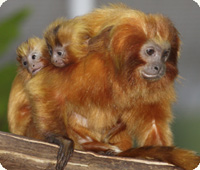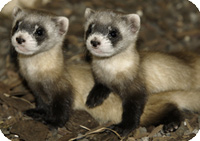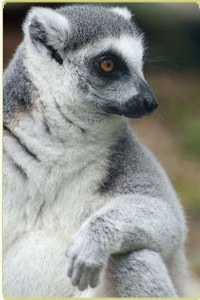Mammals vary in size from the 100-foot-long blue whale to the two-gram bumblebee bat, one of the world's most endangered species. Most mammals measure less than one foot (including the head and body). That makes small mammals far more common, if less well known, than large mammals like elephants, tigers, and people.
Small mammals cut across categories. Most species are rodents (such as the naked mole-rat), insectivores, and bats, but there are also carnivores, such as Asian small-clawed otters, and primates, such as golden lion tamarins and lemurs.
Tamarins at the Small Mammal House
 Golden lion tamarin twins were born at the Zoo's Small Mammal House on July 17. More than 178 golden lion tamarins have been born at the Zoo over the past few decades. The last pair was born in May of 2007.
Golden lion tamarin twins were born at the Zoo's Small Mammal House on July 17. More than 178 golden lion tamarins have been born at the Zoo over the past few decades. The last pair was born in May of 2007.
Golden lion tamarins are usually born in sets of twins, and all members of the family group contribute to caring for and carrying the babies. Golden lion tamarins inhabit the Atlantic coastal forest of Brazil.
There are only 1,500 of these small endangered monkeys left in the wild. In order to ensure their survival, the Zoo has worked with other zoos and conservation organizations to re-introduce zoo-born golden lion tamarins into the wild and restore their habitat. ![]() Learn more.
Learn more.
Ferret Conservation
 The National Zoo's Conservation and Research Center (CRC), in Front Royal, Virginia, has been breeding endangered black-footed ferrets for 20 years to bring them back from the brink of extinction. This year, 21 ferrets were bred at CRC, and several gave birth to litters. One kit was was born on our
The National Zoo's Conservation and Research Center (CRC), in Front Royal, Virginia, has been breeding endangered black-footed ferrets for 20 years to bring them back from the brink of extinction. This year, 21 ferrets were bred at CRC, and several gave birth to litters. One kit was was born on our ![]() web cam on June 20. The kit was the result of artificial insemination.
web cam on June 20. The kit was the result of artificial insemination.
In fact, the father died nine years ago! Semen was collected a couple of years earlier, frozen, and stored in the Zoo’s Black-Footed Ferret Genome Resource Bank, a repository of frozen semen from the most valuable males. In species that have short life spans like the black-footed ferret, the use of cryopreserved, or frozen, sperm extends an individual’s reproductive life. The bank’s contents help maintain and even enhance genetic diversity by infusing new genes into the population. A genetically healthy and diverse population has a greater chance of survival in the wild. The bank also serves as insurance against catastrophes in the wild populations, such as a disease outbreak.
Successful inseminations with frozen semen are extremely rare—until now only three black-footed ferret kits have been born from this method. Another kit was born at CRC the next day, also as a result of insemination with semen that had been collected and frozen in the 1990s.
Ferret cam update: Georgia and her male kit, Peanut, which many people have enjoyed watching on the web cam since June, are now at a facility in Colorado that is managed by the U.S. Fish and Wildlife Service. Georgia is being prepared for release into the wild. Peanut, who is at the age when a young male would go his separate way in the wild, is extremely genetically valuable and will join the breeding program. The ferret now on the cam is named Tilly.
Visitors to the Zoo can see a black-footed ferret in the Zoo's Small Mammal House.
![]() Learn more about black-footed ferret conservation.
Learn more about black-footed ferret conservation.
![]() Small Mammals Photo Gallery |
Small Mammals Photo Gallery |
![]() Help with cam
Help with cam
Can’t see any animals?
The animal in this exhibit may have moved out of view. FONZ volunteers operate some cams, but most of our cams show a fixed view.
Watching golden lion tamarins:
You are viewing an enclosure in the Zoo's Small Mammal House where a family of golden lion tamarins (GLTs) lives. You may see other animals that live here too, such as sloths and acouchis. There are only about 1,500 GLTs in the wild. For decades, Zoo scientists have collaborated with conservation organizations to help save from extinction these small endangered monkeys.
![]() GLT Conservation |
GLT Conservation | ![]() Adopt a Golden Lion Tamarin
Adopt a Golden Lion Tamarin
Black-footed Ferret Cam
Naked Mole-rat
Mammal Mystery
Family members of this species greet with what looks like a kiss. They're not really kissing, but gently touching their front teeth together. ![]() What animals recognize each other this way?
What animals recognize each other this way?
Golden Lion Tamarin Conservation Program
 For
more than 30 years, this program has been saving these small monkeys
through conservation breeding and reintroduction to
their natural habitat in Brazil. Thanks to the success
of the program, the status of GLTs was downgraded from
"critically endangered" to "endangered" by the World Conservation Union (IUCN) in 2003.
For
more than 30 years, this program has been saving these small monkeys
through conservation breeding and reintroduction to
their natural habitat in Brazil. Thanks to the success
of the program, the status of GLTs was downgraded from
"critically endangered" to "endangered" by the World Conservation Union (IUCN) in 2003. ![]() more
more


